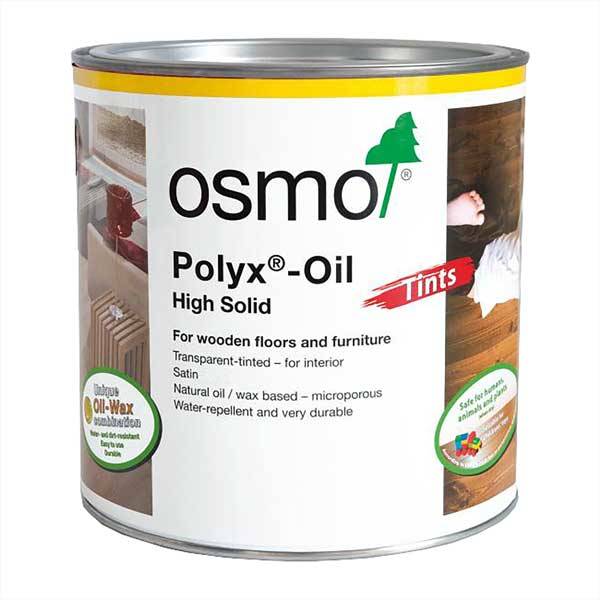





Osmo Polyx Oil Tints is an extremely versatile hardwax oil stain that forms part of Osmo's interior range of finishing oils. Osmo recommend 1 coat of 'tint' followed by 1 coat of Polyx Oil Clear (with the exception of 'White 3040'). Customers have however used just 2 coats of the tint for a stronger depth of colour. 1 coat of tint followed by 1 coat of clear offers marginally better protection.
| Product | Use |
| Osmo Polyx Oil | The original, clear hardwax oil for most interior wooden surfaces |
| Osmo Polyx Oil Raw | Gives your wood the natural "untreated" look |
| Osmo Polyx Oil Anti-Slip | A reduced-slip solution for interior stairs and flooring |
| Osmo Polyx Oil Rapid | Cut drying times in half, for when speed is of the essence |
| Osmo Polyx Oil Express | Osmo's fastest ever drying product |
Top Tip: It's important that the 'White' Polyx Oil 3040 is not over-coated with clear Polyx Oil. This can make the white finish turn a 'creamy' or 'off-white' colour. To retain the white finish, Osmo recommend that Polyx Oil White 3040 is over-coated with Osmo Polyx Oil Raw (3044).
Surfaces must be clean and dry, removing all traces of dust and dirt before application (maximum moisture content 20%). Only apply on a frost-free surface. For guaranteed performance, Osmo recommend that all traces of previous finishes are removed to expose clean, bare wood.
Always do a test area before starting any project to assess product suitability and final finish. If you have a 5ml sample, squeeze the sachet thoroughly to mix the product before opening. Follow the manufacturer's instructions on the tin at all times. Osmo Polyx-Oil Tints is ready-to-use from the tin, do not thin. Stir thoroughly prior and periodically during application to ensure a consistent finish. Osmo oils dry via oxidation so it is important to ensure good ventilation during application and drying.
The ideal application tool is a firm, fine, natural bristled brush. For the best results, apply thinly and remove any excess oil from the surface of the wood with a clean, lint-free cloth.
Cork tiles are best treated before fitting to avoid overlapping treatment of edges which would lead to prolonged drying times. A cork floor treated with Osmo Polyx-Oil Tints will get a robust, elastic and wear-resistant surface which will harden further over 2-3 weeks. Due to the extreme absorption power of this highly elastic, natural, material we recommend the following procedure:
For daily maintenance a duster, mop or vacuum cleaner will be sufficient. For commercial premises, an electric floor polisher can be used.
For optimal cleaning of floors treated with Osmo Polyx Oil Tints, we recommend the Osmo Floor Maintenance Kit.
For regular cleaning, we recommend using Osmo Wash and Care or Osmo Spray Cleaner.
For stubborn scuffs and stains, we recommend Osmo Liquid Wax Cleaner or Osmo Intensive Cleaner.
Please Note: Oiled or waxed surfaces should not be cleaned with a steam cleaner or steam mop as this degrades the performance of the finish.
For renovation, simply re-apply a thin coat of Osmo Polyx Oil Tints to worn areas. No sanding is required, and no removal of a previous Polyx Oil finish. No repair marks will be visible if applied thinly and appropriately.
Please Note: If the original area was treated with Polyx Oil Tints, then over-coated with a clear coat of Osmo Polyx Oil, it may only be the top coat that has been worn or damaged. In this instance, simply re-apply a thin coat of clear Osmo Polyx Oil to the damaged areas.
If the damage runs deeper to the coloured finish or the wood then both products will be required.
Colours can be difficult when looking at screens. It is also important to remember that each colour will look slightly different on each timber, even when using on the same species as the grain depth and porosity will always differ
Each of the Polyx Oil Tints are available in sample sizes to allow you to test the colours on your timber before going ahead with the larger scale project. You can get in touch by calling us on 01303 213838 to discuss your options.